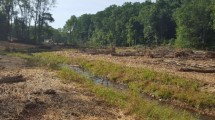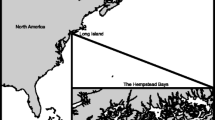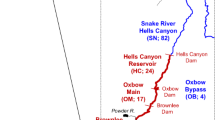Abstract
Removal of nonnative riparian trees is accelerating to conserve water and improve habitat for native species. Widespread control of dominant species, however, can lead to unintended erosion. Helicopter herbicide application in 2003 along a 12-km reach of the Rio Puerco, New Mexico, eliminated the target invasive species saltcedar (Tamarix spp.), which dominated the floodplain, as well as the native species sandbar willow (Salix exigua Nuttall), which occurred as a fringe along the channel. Herbicide application initiated a natural experiment testing the importance of riparian vegetation for bank stability along this data-rich river. A flood three years later eroded about 680,000 m3 of sediment, increasing mean channel width of the sprayed reach by 84%. Erosion upstream and downstream from the sprayed reach during this flood was inconsequential. Sand eroded from channel banks was transported an average of 5 km downstream and deposited on the floodplain and channel bed. Although vegetation was killed across the floodplain in the sprayed reach, erosion was almost entirely confined to the channel banks. The absence of dense, flexible woody stems on the banks reduced drag on the flow, leading to high shear stress at the toe of the banks, fluvial erosion, bank undercutting, and mass failure. The potential for increased erosion must be included in consideration of phreatophyte control projects.



Similar content being viewed by others
References
Auble GT, Scott ML, Friedman JM, Back J, Lee VJ (1997) Constraints on establishment of plains cottonwood in an urban riparian preserve. Wetlands 17:138–148
Barz D, Watson RP, Kanney JF, Roberts JD, Groeneveld DP (2009) Cost/benefit considerations for recent saltcedar control, Middle Pecos River, New Mexico. Environmental Management 43:282–298
Birken AS, Cooper DJ (2006) Processes of Tamarix invasion and floodplain development along the lower Green River, Utah. Ecological Applications 16:1103–1120
Brinson MM, Swift BL, Plantico RC, Barclay JS (1981) Riparian ecosystems: their ecology and status. US Fish and Wildlife Service Biological Report 81/17, Washington, DC, 155 pp
Bryan K (1928) Historic evidence on changes in the channel of Rio Puerco, a tributary of the Rio Grande in New Mexico. Journal of Geology 36:265–282
Bryan K, Post GM (1927) Erosion and control of silt on the Rio Puerco, New Mexico. Report to the Chief Engineer, Middle Rio Grande Conservancy District, Albuquerque, NM
Clapp EM, Bierman PR, Nichols KK, Pavich M, Caffee M (2001) Rates of sediment supply to arroyos from upland erosion determined using in situ produced cosmogenic 10Be and 26Al. Quaternary Research 55:235–245
Collins K, Ferrari R (2000) Elephant Butte Reservoir, 1999 Sedimentation Survey. Sedimentation and River Hydraulics Group, report, 136 pp, Technical Service Center, Bureau of Reclamation, Denver, CO
D’Antonio C, Meyerson LA (2002) Exotic plant species as problems and solutions in ecological restoration: a synthesis. Restoration Ecology 10:703–713
De Baets S, Poesen J, Knapen A, Barberá GG, Navarro JA (2007) Root characteristics of representative Mediterranean plant species and their erosion-reducing potential during concentrated runoff. Plant Soil 294:169–183
Elliott JG, Gellis AC, Aby SB (1999) Evolution of arroyos: incised channels of the southwestern United States. In: Darby SE, Simon A (eds) Incised river channels. Wiley, New Jersey, pp 153–185
Emslie SD (1981) Prehistoric agricultural ecosystems: avifauna from Pottery Mound, New Mexico. American Antiquity 46:853–861
Everitt BL (1998) Chronology of the spread of tamarisk in the central Rio Grande. Wetlands 18:658–668
Friedman JM, Lee VJ (2002) Extreme floods, channel change, and riparian forests along ephemeral streams. Ecological Monographs 72:409–425
Friedman JM, Auble GT, Shafroth PB, Scott ML, Merigliano MF, Freehling MD, Griffin ER (2005a) Dominance of non-native riparian trees in western USA. Biological Invasions 7:747–751
Friedman JM, Vincent KR, Shafroth PB (2005b) Dating flood-plain sediments using tree-ring response to burial. Earth Surface Processes and Landforms 30:1077–1091
Gaskin JF, Schaal BA (2002) Hybrid Tamarix widespread in US invasion and undetected in native Asian range. Proceedings of the National Academy of Sciences 99:11256–11259
Graf WL (1978) Fluvial adjustments to the spread of tamarisk in the Colorado Plateau region. Geological Society of America Bulletin 89:1491–1501
Graf WL (2006) Downstream hydrologic and geomorphic effects of large dams on American rivers. Geomorphology 79:336–360
Griffin ER, Kean JW, Vincent KR, Smith JD, Friedman JM (2005) Modeling effects of bank friction and woody bank vegetation on channel flow and boundary shear stress in the Rio Puerco, New Mexico. Journal of Geophysical Research 110:F04023
Hart CR, White LD, McDonald A, Sheng Z (2005) Saltcedar control and water salvage on the Pecos River, Texas, 1999–2003. Journal of Environmental Management 75:399–409
Heath DL (1983) Flood and recharge relationships of the lower Rio Puerco, New Mexico. M.S. Thesis, New Mexico Institute of Mining and Technology, Socorro, NM
Hickin EJ (1984) Vegetation and river channel dynamics. The Canadian Geographer 28:111–126
Holmes PM, Richardson DM, Esler KJ, Witkowski ETF, Fourie S (2005) A decision-making framework for restoring riparian zones degraded by invasive alien plants in South Africa. South African Journal of Science 101:553–564
Ikenson B (2002) Rio Grande silvery minnow. Endangered Species Bulletin 27:34–35
Katz GL, Shafroth PB (2003) Biology, ecology and management of Elaeagnus angustifolia L. (Russian olive) in western North America. Wetlands 23:763–777
Kean JW, Smith JD (2004) Flow and boundary shear stress in channels with woody bank vegetation. In: Bennett S, Simon A (eds) Riparian vegetation and fluvial geomorphology. Water science and applications, vol 8. American Geophysical Union, Washington, DC, pp 237–252
Love DW (1986) A geological perspective of sediment storage and delivery along the Rio Puerco, central New Mexico. In: Hadley RF (ed) Drainage basin sediment delivery. IAHS Publication 159, International Association of Hydrological Sciences Press, Wallingford, UK, pp 305–322
Millar RG (2000) Influence of bank vegetation on alluvial channel patterns. Water Resources Research 36:1109–1118
Molnar P, Ramirez JA (2001) Recent trends in precipitation and streamflow in the Rio Puerco Basin. Journal of Climate 14:2317–2328
Naiman RJ, Decamps H, McClain ME (2005) Riparia: ecology, conservation, and management of streamside communities. Elsevier Academic Press, San Diego, CA
NAVSTAR GPS User Equipment Introduction, Public Release Version (1996) http://www.navcen.uscg.gov/pubs/gps/gpsuser/gpsuser.pdf. Accessed 11 April 2008, 215 pp
New Mexico Geospatial Data Acquisition Committee (2006) 2005 New Mexico DOQQs, State of New Mexico, Albuquerque, New Mexico. http://rgis.unm.edu/. Accessed 10/18/2006
Nordin CF Jr (1963) A preliminary study of sediment transport parameters, Rio Puerco near Bernardo, New Mexico. U.S. Geological Survey Professional Paper 462-C. U.S. Geological Survey, Washington, DC
Papanicolaou AN, Elhakeem M, Hilldale R (2007) Secondary current effects on cohesive river bank erosion. Water Resources Research. doi:10.1029/2006WR005763
Pierce MH (1962) The Atchison, Topeka and Santa Fe Railway Company v. the United States. In: Cases decided in the United States Court of Claims June 1, 1960 to July 31, 1960. Volume CL, US Government Printing Office, Washington DC, pp 339–386
Pollen-Bankhead N, Simon A, Jaeger K, Wohl E (2009) Destabilization of streambanks by removal of invasive species in Canyon de Chelly National Monument, Arizona. Geomorphology 103:363–374
Richardson DM, Holmes PM, Esler KJ, Galatowitsch SM, Stromberg JC, Kirkman SP, Pysek P, Hobbs RJ (2007) Riparian vegetation: degradation, alien plant invasions, and restoration prospects. Diversity and Distributions 13:126–139
Satalich J, Ricketson R (1998) Field test of Trimble 4000 real-time kinematic GPS survey system. Journal of Surveying Engineering 124:40–48
Schmidt KM, Roering JJ, Stock JD, Dietrich WE, Montgomery DR, Schaub T (2001) Root cohesion variability and shallow landslide susceptibility in the Oregon Coast Range. Canadian Geotechnical Journal 38:995–1024
Shafroth PB, Cleverly JR, Dudley TL, Taylor JP, van Riper CIII, Weeks EP, Stuart JN (2005) Control of Tamarix in the western United States: implications for water salvage, wildlife use, and riparian restoration. Environmental Management 35:231–246
Shafroth PB, Beauchamp VB, Briggs MK, Lair K, Scott ML, Sher AA (2008) Planning riparian restoration in the context of Tamarix control in western North America. Restoration Ecology 16:97–112
Shields A (1936) Application of similarity principles and turbulence research to bed-load movement. Mitteilung Preussische Versuchsanstalt für Wasserbau und Schiffbau, 26, Berlin. In: Ott WP, Uchelen JC (translators) W. M. Kech Laboratory of Hydraulics and Water Resources Report 167, California Institute of Technology, Pasadena, CA
Simon A, Collison AJC (2002) Quantifying the mechanical and hydrologic effects of riparian vegetation on streambank stability. Earth Surface Processes and Landforms 27:527–546
Smith D (1976) Effect of vegetation on lateral migration of anastomosed channels of a glacial meltwater river. Geological Society of America Bulletin 87:857–860
Smith JD (2004) The role of riparian shrubs in preventing floodplain unraveling along the Clark Fork of the Columbia River in the Deer Lodge Valley, Montana. In: Bennett S, Simon A (eds) Riparian vegetation and fluvial geomorphology. Water science and applications, vol 8. American Geophysical Union, Washington, DC, pp 71–85
Smith JD (2007) Beaver, willow shrubs and floods. In: Johnson EA, Miyanishi K (eds) Plant disturbance ecology: the process and the response. Elsevier Academic Press, Burlington, MA, pp 603–672
Smith JD, Griffin ER (2002) Relation between geomorphic stability and the density of large shrubs on the flood plain of the Clark Fork of the Columbia River in the Deer Lodge Valley, Montana. U.S. Geological Survey Water-Resources Investigations Report 02-4070, U.S. Geological Survey, Boulder, CO
Stromberg JC, Shafroth PB, Shorrock D, White JM, White MS, Lite SL, Marler R, Paradzick C (2007) Altered stream-flow regimes and invasive plant species: the Tamarix case. Global Ecology and Biogeography 16:381–393
Thorne CR, Tovey NK (1981) Stability of composite river banks. Earth Surface Processes and Landforms 6:469–484
Trimble SW (2004) Effects of riparian vegetation on stream channel stability and sediment budgets. In: Bennett S, Simon A (eds) Riparian vegetation and fluvial geomorphology. Water science and applications, vol 8. American Geophysical Union, Washington, DC, pp 153–169
Trimble Navigation Limited (2004) Trimble 5800 GPS system datasheet, Trimble Engineering and Construction Group, Dayton, OH. http://www.trimble.com/
Vivoni ER, Bowman RS, Wyckoff RL, Jakubowski RT, Richards KE (2006) Analysis of a monsoon flood event in an ephemeral tributary and its downstream hydrologic effects. Water Resources Research 42:W03404
Wolman MG, Gerson R (1978) Relative scales of time and effectiveness of climate in watershed geomorphology. Earth Surface Processes 3:189–208
Zavaleta E (2000) The economic value of controlling an invasive shrub. Ambio 29:462–467
Acknowledgments
This research was funded by the Central Region Integrated Science Program of the U.S. Geological Survey. LIDAR acquisition was overseen by Vivian Queija and carried out by Spectrum Mapping, LLC. Terry Waddle and Julie Roth assisted with the 2007 GPS survey, and Zack Bowen and Jason Kean assisted with the 2002 topographic surveys. Larry Benson, Chris Holmquist-Johnson, Ray Watts, Juliette Wilson, and four anonymous referees provided constructive reviews. Use of trade names or company names does not constitute endorsement by the U.S. Geological Survey.
Author information
Authors and Affiliations
Corresponding author
Rights and permissions
About this article
Cite this article
Vincent, K.R., Friedman, J.M. & Griffin, E.R. Erosional Consequence of Saltcedar Control. Environmental Management 44, 218–227 (2009). https://doi.org/10.1007/s00267-009-9314-8
Received:
Revised:
Accepted:
Published:
Issue Date:
DOI: https://doi.org/10.1007/s00267-009-9314-8




